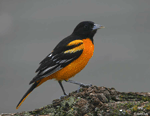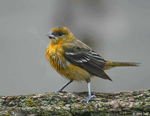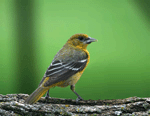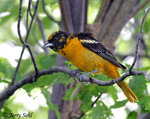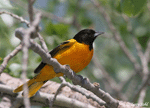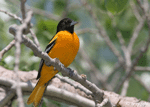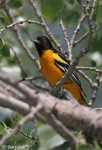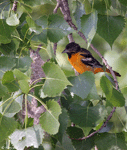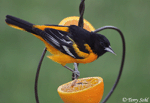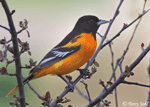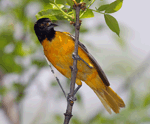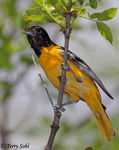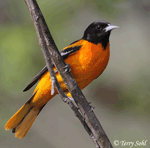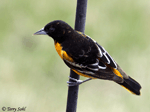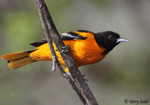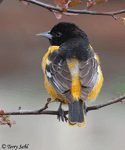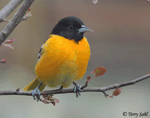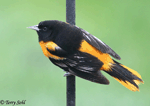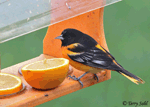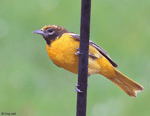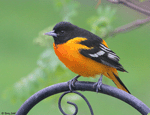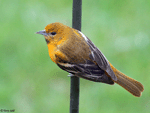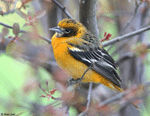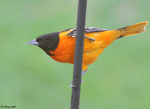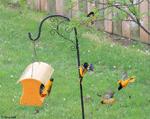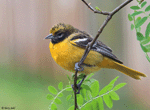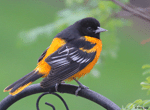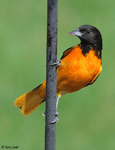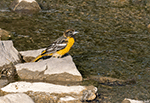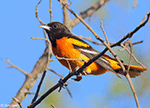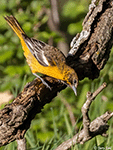Baltimore Oriole
Icterus galbula
| Length: 7 - 8 inches | Wingspan: 11 - 12 inches | Seasonality: Summer |
| ID Keys: Black hood and back, with orange underparts, rump, and shoulder patch. | ||
 This
bird was formerly considered to belong to the same species as the western
Bullock's Oriole, under the combined name of "Northern Oriole". South
Dakota birds can be variously intermediate between the two species, as they
interbreed where their ranges come into contact. However, in general, Baltimore
Orioles are found in the eastern part of South Dakota, while Bullock's Orioles
are found in the western part. The species was originally named for Lord
Baltimore, whose coat-of-arms had similar colors to the Baltimore Oriole.
This
bird was formerly considered to belong to the same species as the western
Bullock's Oriole, under the combined name of "Northern Oriole". South
Dakota birds can be variously intermediate between the two species, as they
interbreed where their ranges come into contact. However, in general, Baltimore
Orioles are found in the eastern part of South Dakota, while Bullock's Orioles
are found in the western part. The species was originally named for Lord
Baltimore, whose coat-of-arms had similar colors to the Baltimore Oriole.
Habitat:
Baltimore Orioles typically nest in deciduous trees, but they usually shun deep, unbroken forest and are instead found around more open woodlands, riparian areas, shelterbelts, and other areas adjacent to some open space. They are also very well adapted to a human presence and can often be found in residential areas and urban parks.
Diet:
Insects, berries, and nectar. In summer, primarily insects. Eats many berries and sometimes cultivated fruit
Behavior:
Forages by moving through the foliage of trees and shrubs in search of insects. Will also go take nectar from flowers.
Nesting:
Mid-May through August in South Dakota. The nest is a large hanging bag-shaped pouch of grasses, vines, string, bark strips, or other linear, thin material. The female lays 4 or 5 eggs, with the female alone incubating them. After the eggs hatch, both parents help to feed the nestlings, who leave the nest after about 2 weeks.
Interactive eBird Map:
Click to access an interactive eBird map of Baltimore Oriole sightings
Song:
Baltimore Oriole males sing a beautiful, extremely melodic and musical song, consisting of a series of musical phrases that is often quite variable. When alarmed or defending a nest, they also have a harsher chattering call. Both males and females also have a variety of different call notes.
- Click here to hear the song of a Baltimore Oriole1
- Click here to hear another song of a Baltimore Oriole2
- Click here to hear the scolding chatters of a Baltimore Oriole3
- Click here to hear shorter call notes of a Baltimore Oriole4
Migration:
Neotropical migrant, although some may winter in the Southeastern U.S. Generally migrates quite early in the fall.
Similar Species:
In South Dakota, there are two other Oriole species, both of which could pose an identification challenge. Oriole species outside of South Dakota could also be confused with a Baltimore Oriole.
- Bullock's Oriole - Given Bullock's Orioles were once considered the same species, you'd suspect some identification challenges. Bullock's Oriole are found in the western US, and Baltimore Orioles in the east, and that split also generally applies in South Dakota, where the ranges of the two species meet. Male Bullock's Orioles have an orange face with dark eyeline, while male Baltimore Orioles have a completely black head. Male Bullock's Orioles also have a broad white wing patch not present on Baltimore Orioles. Females of the two species are more difficult to differentiate. Plumages are similar, but female Bullock's Orioles have a whitish belly, while that of a female Baltimore Oriole is a light orange. Click here to see a more detailed comparison between the two species.
- Orchard Oriole - Orchard Orioles are a common oriole species across the state. They're smaller than a Baltimore Oriole. Male Orchard Orioles are a ruddy reddish color, while Baltimore Orioles are a much brighter orange. Females again are more difficult to differentiate. Female Orchard Orioles are more yellowish overall while Baltimore Orioles are more orangish, but color can be difficult to judge depending upon lighting. Female Orchard Orioles also have a more uniform coloring on their back, while female Baltimore Orioles have some darker scaly patterns on their upper back.
- Hooded Oriole - Not an identification challenge in South Dakota, but it could potentially be an issue in southern Texas and Mexico, the portion of a Hooded Orioles range that may overlap with summering or migrating Baltimore Orioles. Male Hooded Warblers have a different head pattern, with an orange head, and black face and throat. Male Baltimore Orioles have a completely black head. Color is the best way to differentiate females, as female Hooded Orioles are more yellowish and female Baltimore Orioles are more orangish.
- Altamira Oriole - Another oriole species where range overlap with Baltimore Orioles is only likely in southern Texas and Mexico. Altamira Orioles are unique of the orioles on this list in that both males and females have generally similar plumage. Their orange head with black throat and face distinguish them from the black head of a Baltimore Oriole male.
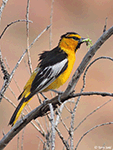 |
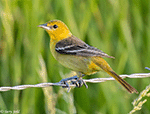 |
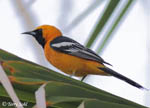 |
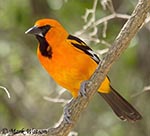 |
| Bullock's Oriole (male) | Orchard Oriole (female) | Hooded Oriole (male) | Altamira Oriole |
Bird Feeders:
Oranges, peanut butter and suet, sometimes sugar water/nectar. Specialized "oriole feeders" are sold which help birders offer fruit, jelly, or nectar to oriole species.
Conservation Status:
Baltimore Orioles are found across a very broad geographic area, and are common in many parts of that range. Their overall populations also appear to be relatively stable, based on systematic surveys like the Breeding Bird Survey. The IUCN lists the Baltimore Oriole as a species of "Least Concern".
Further Information:
- USGS Patuxent Bird Identification InfoCenter, Baltimore Oriole
- Audubon's Field Guide - Baltimore Oriole
- WhatBird - Baltimore Oriole
Photo Information:
May 20th, 2004 -- Home in Brandon -- Terry Sohl
Additional Photos:
Click on the image chips or text links below for additional, higher-resolution Baltimore Oriole photos.
Audio File Credits:
- 1Jim Berry. Recorded in Chautauqua County, New York on May 10th, 2015. Original recording and information from xeno-canto.
- 2David Darrell-Lambert. Recorded in Essex County, Ontario on May 13th, 2019. Original recording and information from xeno-canto.
- 3Eric Defonso. Recorded in Logan County, Colorado on June 1st, 2016. Original recording and information from xeno-canto.
- 4Dan Lane. Recorded in East Baton Rouge Parish, Louisiana on April 20th, 2014. Original recording and information from xeno-canto.
| Click on the map below for a higher-resolution view |
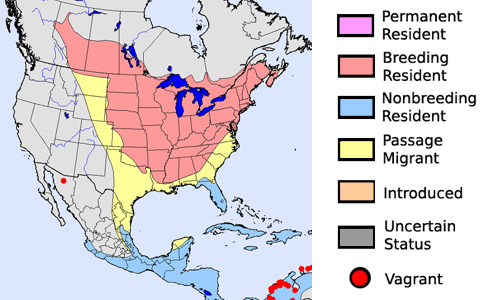 |
| South Dakota Status: Common migrant and Summer breeder in the eastern part of the state. Uncommon in the western part of the state. |
Additional Baltimore Oriole Photos
Click for a higher-resolution version of these photos
